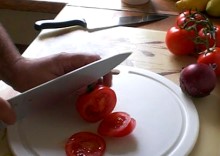Sharp Knife vs Blunt Knife - Which Is Safer To Use?
By Mike on Sunday, July 1, 2012, 21:53 - Permalink
 It's often said that you're less likely to cut yourself with a sharp kitchen knife than you are with a blunt one.
It's often said that you're less likely to cut yourself with a sharp kitchen knife than you are with a blunt one.
On the face of it, that sounds like it shouldn't be true - but in fact, it probably is...
Here's a short video explaining some of the reasoning.
Can It Really Be True?
So is it really true that a sharp knife is safer than a blunt one?
Well, yes - but it's a qualified yes. A sharp knife used properly is safer than a blunt knife used in the same way.
Background And Explanation
The main reason it's safer is that a sharp knife will do what you intend to do - it will cut things - it will cut cleanly and decisively - so as long as you're not doing anything stupid (like cutting toward your fingers), the knife will perform the cutting operation with precision and predictability, and with minimal application of force.
A blunt knife, on the other hand, is quite likely to slip off the surface of some harder or tougher objects - and this means it will go in a direction you did not intend - perhaps in the direction of your fingers. To compensate for the loss of cutting action, you'll find yourself applying more force - which means you may no longer be in control of the blade; you might not even be holding it properly any more - and then, when the blade still slips and goes where it isn't meant to, it will arrive with far greater force, possibly cutting you quite badly.
A blunt knife also tends to crush the food, rather than cutting it - so with something like an onion, the layers will separate and this will again cause the blade to go off course - you'll then spend more time and effort trying to cut the pieces smaller - and all at a higher general risk of injury.
The Moral
The moral of the story is, then:
Keep your knives sharp - A chef would probably recommend a rod-type steel knife sharpener, but that requires a lot of practice to perfect. For amateurs like me, a compact crossed-steels sharpener is perfectly adequate - the kinfe is pressed down into the slot and drawn through once or twice, leaving a very nice, sharp edge.
Use proper technique - when slicing something like a halved onion, or a cucumber or carrot, your fingertips should be tucked back out of the way, so the broad flat side of the knife can be guided by the second joint of your fingers, not the tips. You should never be cutting towards, or directly against any part of your hand or body.
Note
Before, during or after the video(s) embedded in this page, the player may display advertisements or links to additional videos - these are not affiliated to Atomic Shrimp and the selection is something over which I have no control.
